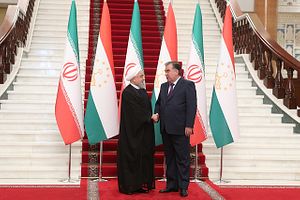Tajikistan and Iran have agreed to invest $8 million more into construction of the Istiqlol tunnel. According to Akipress, Tajikistan and Iran signed an agreement in which each size will commit $4 million in financing to finish the tunnel. Each side will finance $4 million to finish the tunnel with ventilation, sprinkler and traffic and safety control systems.
The tunnel has as checkered a history as Tajik-Iranian relations over the past few years. An agreement to do more work on the tunnel is the latest gesture within an improving relationship.
The Istiqlol tunnel, also called the Anzob Tunnel, is 3.1 miles long and cuts the travel time between Dushanbe and Tajikistan’s second-largest city, Khujand, dramatically. Because of Tajikistan’s geography, traveling between the capital and Khujand requires either going through the tunnel or through Uzbekistan, which until recently was considerably more difficult. The partially completed tunnel initially opened in 2006. With an original price tag of $4 billion, what opened quickly earned the moniker “tunnel of death.” In 2014, Iran and Tajikistan signed another agreement, worth $3 billion, to complete the tunnel by the following March. But in June 2015 the tunnel was closed again and reopened that September.
As a post on travel and curiosity site Atlas Obscura noted, “Other than giant, water-filled potholes, no lights, every-man-for-himself navigation, toxic gasses and the sporadic avalanche, the Anzob Tunnel is totally safe.” An update at the foot of the post comments that conditions as of 2018 were much improved.
The additional funds for the tunnel mark an improvement in Tajik-Iran relations which had deteriorated markedly in 2015, when the last improvements to the tunnel were made. That year, the Tajik government cracked down hard on the Islamic Renaissance Party (IRPT). In late December 2015, Iran hosted the 29th Islamic Unity Conference and sat IRPT representatives right next to the Tajik delegation. In the ensuing years, Tajikistan has periodically slipped negative references to Iran into key moments. For example, a state TV documentary that aired in the late summer of 2017 accused Iran of stoking the 1992-1997 Tajik Civil War by providing funds to the Islamist opposition and training militants.
But even before the IRPT argument, the Tajik-Iran bilateral was periodically rocky. Indeed, in 2014, Seyed Mahmoud Sadri — who media reports referred to as the “caretaker” of the Iranian diplomatic mission in Dushanbe at the time — was quoted as rejecting reports that Tajik-Iranian cooperation had declined.
The ebbs and flows of Tajikistan-Iran relations are influenced by many moons, perhaps the largest being the associated relationship between Tajikistan and Saudi Arabia, Iran’s nemesis. The current tide is no different.
As an analysis in Al-Monitor noted recently, Iran has been on the hunt for relief from U.S. sanctions and looking to Asia in particular. The first foreign trips by Iranian President Hassan Rouhani since May 8 — when Iran announced it would no longer hold to all of the commitments of the nuclear deal reached in 2015 (which U.S. President Doanld Trump withdrew from in May 2018) — were to Kyrgyzstan and Tajikistan in June.
In Kyrgyzstan, Rouhani attended the Shanghai Cooperation Organization summit. Iran is an observer of the group that includes China, Russia, Kazakhstan, Kyrgyzstan, Tajikistan, Uzbekistan, India and Pakistan as members. In Tajikistan, Rouhani attended the Conference on Interaction and Confidence-Building Measures (CICA). Between the two summits, Rouhani got facetime with key leaders like Chinese President Xi Jinping and Russian President Vladimir Putin, not to mention Tajik President Emomali Rahmon, of course.
The moment is ripe, for many reasons, for a thaw in relations between Iran and Tajikistan. Last month, Eurasianet noted that an Iranian news website had deleted an old interview with the IRPT’s leader, Muhiddin Kabiri, and officials had made other comments underscoring a distancing from the party. In turn, in early June Tajikistan’s foreign minister skipped the Organization for Islamic Cooperation summit in Saudi Arabia to visit Tehran. The tunnel news this week is just another hint that the pendulum is tilting Tajikistan back toward Iran for now.

































